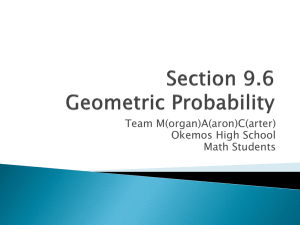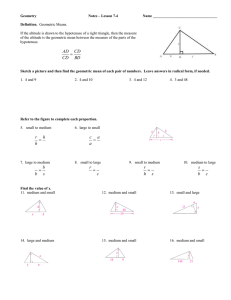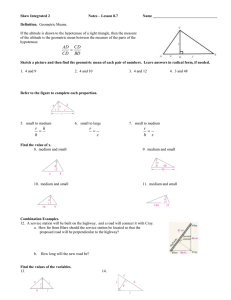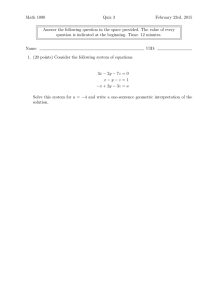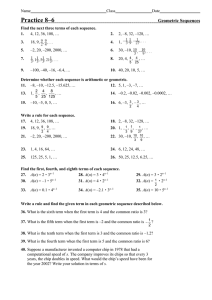A SYSTEMIC APPROACH FOR 3D RECOGNITION OF
advertisement
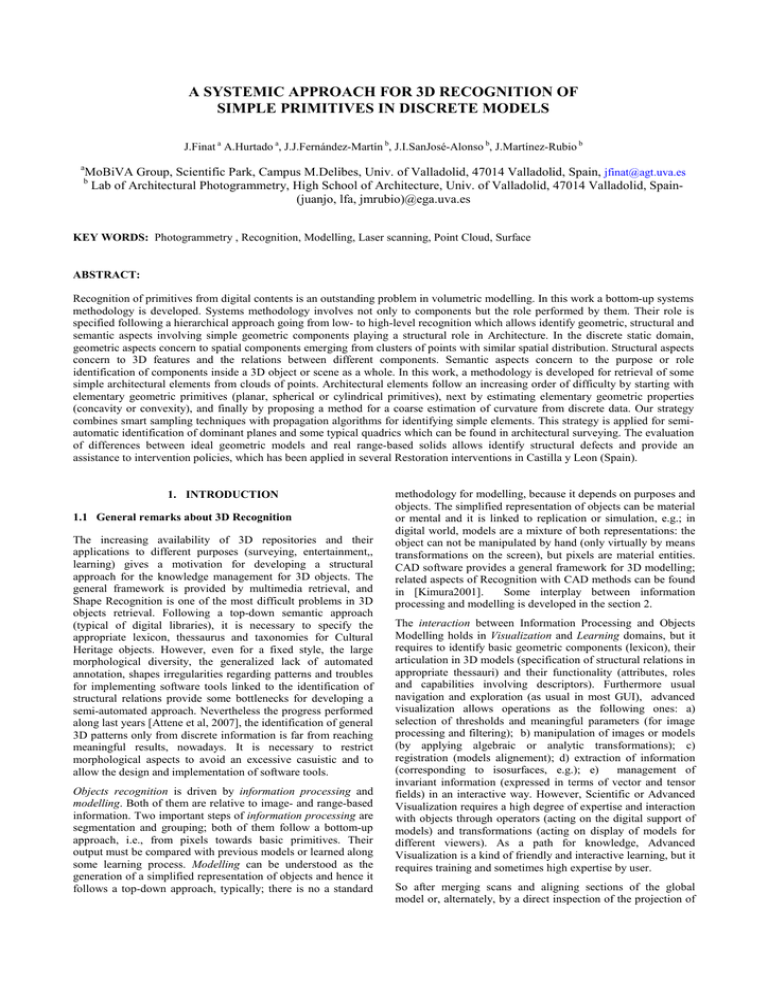
A SYSTEMIC APPROACH FOR 3D RECOGNITION OF SIMPLE PRIMITIVES IN DISCRETE MODELS J.Finat a A.Hurtado a, J.J.Fernández-Martín b, J.I.SanJosé-Alonso b, J.Martínez-Rubio b a MoBiVA Group, Scientific Park, Campus M.Delibes, Univ. of Valladolid, 47014 Valladolid, Spain, jfinat@agt.uva.es Lab of Architectural Photogrammetry, High School of Architecture, Univ. of Valladolid, 47014 Valladolid, Spain(juanjo, lfa, jmrubio)@ega.uva.es b KEY WORDS: Photogrammetry , Recognition, Modelling, Laser scanning, Point Cloud, Surface ABSTRACT: Recognition of primitives from digital contents is an outstanding problem in volumetric modelling. In this work a bottom-up systems methodology is developed. Systems methodology involves not only to components but the role performed by them. Their role is specified following a hierarchical approach going from low- to high-level recognition which allows identify geometric, structural and semantic aspects involving simple geometric components playing a structural role in Architecture. In the discrete static domain, geometric aspects concern to spatial components emerging from clusters of points with similar spatial distribution. Structural aspects concern to 3D features and the relations between different components. Semantic aspects concern to the purpose or role identification of components inside a 3D object or scene as a whole. In this work, a methodology is developed for retrieval of some simple architectural elements from clouds of points. Architectural elements follow an increasing order of difficulty by starting with elementary geometric primitives (planar, spherical or cylindrical primitives), next by estimating elementary geometric properties (concavity or convexity), and finally by proposing a method for a coarse estimation of curvature from discrete data. Our strategy combines smart sampling techniques with propagation algorithms for identifying simple elements. This strategy is applied for semiautomatic identification of dominant planes and some typical quadrics which can be found in architectural surveying. The evaluation of differences between ideal geometric models and real range-based solids allows identify structural defects and provide an assistance to intervention policies, which has been applied in several Restoration interventions in Castilla y Leon (Spain). 1. INTRODUCTION 1.1 General remarks about 3D Recognition The increasing availability of 3D repositories and their applications to different purposes (surveying, entertainment,, learning) gives a motivation for developing a structural approach for the knowledge management for 3D objects. The general framework is provided by multimedia retrieval, and Shape Recognition is one of the most difficult problems in 3D objects retrieval. Following a top-down semantic approach (typical of digital libraries), it is necessary to specify the appropriate lexicon, thessaurus and taxonomies for Cultural Heritage objects. However, even for a fixed style, the large morphological diversity, the generalized lack of automated annotation, shapes irregularities regarding patterns and troubles for implementing software tools linked to the identification of structural relations provide some bottlenecks for developing a semi-automated approach. Nevertheless the progress performed along last years [Attene et al, 2007], the identification of general 3D patterns only from discrete information is far from reaching meaningful results, nowadays. It is necessary to restrict morphological aspects to avoid an excessive casuistic and to allow the design and implementation of software tools. Objects recognition is driven by information processing and modelling. Both of them are relative to image- and range-based information. Two important steps of information processing are segmentation and grouping; both of them follow a bottom-up approach, i.e., from pixels towards basic primitives. Their output must be compared with previous models or learned along some learning process. Modelling can be understood as the generation of a simplified representation of objects and hence it follows a top-down approach, typically; there is no a standard methodology for modelling, because it depends on purposes and objects. The simplified representation of objects can be material or mental and it is linked to replication or simulation, e.g.; in digital world, models are a mixture of both representations: the object can not be manipulated by hand (only virtually by means transformations on the screen), but pixels are material entities. CAD software provides a general framework for 3D modelling; related aspects of Recognition with CAD methods can be found in [Kimura2001]. Some interplay between information processing and modelling is developed in the section 2. The interaction between Information Processing and Objects Modelling holds in Visualization and Learning domains, but it requires to identify basic geometric components (lexicon), their articulation in 3D models (specification of structural relations in appropriate thessauri) and their functionality (attributes, roles and capabilities involving descriptors). Furthermore usual navigation and exploration (as usual in most GUI), advanced visualization allows operations as the following ones: a) selection of thresholds and meaningful parameters (for image processing and filtering); b) manipulation of images or models (by applying algebraic or analytic transformations); c) registration (models alignement); d) extraction of information (corresponding to isosurfaces, e.g.); e) management of invariant information (expressed in terms of vector and tensor fields) in an interactive way. However, Scientific or Advanced Visualization requires a high degree of expertise and interaction with objects through operators (acting on the digital support of models) and transformations (acting on display of models for different viewers). As a path for knowledge, Advanced Visualization is a kind of friendly and interactive learning, but it requires training and sometimes high expertise by user. So after merging scans and aligning sections of the global model or, alternately, by a direct inspection of the projection of slices, it is possible to detect structural problems and measure them directly on the cloud. The next figure illustrates some structural problems involving the roof of the church of Villamoron (Burgos, Spain) Fig. 1: Global registration for detecting structural defects in the church of Villamoron (Burgos, Spain) After merging data, diagnostics is almost obvious for an expert, but this knowledge must be translated to machine learning for estimating quantitative information and assessing possible interventions. Most approaches developed for Recognition of 2D objects based in image information are waiting for a similar development in 3D objects based in range infiormation. Furthermore, in some cases the answer is not so obvious and requires an interactive exploration of the volumetric model with assistance for local detection of geometric primitives and expected relations between them. A semantic approach provides the right framework for theis problem. 1.2 Elements for a Semantic approach Semantic approaches to the Recognition problem for a specific domain includes an articulation between lexicon (typical terms), a thesaurus (terminology universally acknowledged by experts) and a taxonomy (system of rules). The most difficult part concerns to the specification of a system of rules, i.e. a specific taxonomy, for each domain of knowledge. Up to very formal languages (mathematical or physical domains, e.g.), there is no agreement for any of the three above fields (lexicon, thesauri, taxonomy). Thus, standardization and consequently interopoerability are difficult tasks; for Cultural Heritage standardization, some advances for interventions are being developed in the framework of CEN346. Nowadays, most approaches to learning follow a supervised strategy with deductive methods from accepted rules with a large consensus by experts. The lowest level corresponds to the identification of basic components or primitives and their assembly in models with increasing complexity. This rules-based approach is enough for geometric and structural aspects of 3D Recognition problems (based in Propostional Logic), but not enough for functionalities whose taxonomies (controlled by some kind of Descriptive Logics) is far more difficult of representing and implementing. The extraction and assembly of basic primitives can be understood as some kind of taxonomy in Image Processing (bottom-up) or CAD (top-down) methodologies. However, there is no a unique taxonomy not even for image processing operations or geometric transformations, still. Furthermore, the stylistic diversity (even in the same architectural tradition) is a proof of troubles for defining a general and efficient taxonomy. Thus, even under the risk of developing a too casuistic approach, it is necessary to restrict the knowledge domain and develop ad hoc approaches. The case-based analysis has been well understood in Computer Vision, where it is necessary to restrict the style for recognition of architectural primitives appearing in images. To begin with, we have restricted ourselves to geometric and structural aspects. Semantic aspects based in components analysis can be included in Systemic approaches. Systems methodology involves not only to components description (in geometric or architectural terms, e.g.) but the role performed by them, also. Their role is specified following a hierarchical approach going from lowlevel to high-level recognition which allows identify geometric, structural and semantic aspects of components, models and functionalities. In the discrete static domain, geometric aspects concern to spatial components which can be described following a top-down approach (ideal surfaces or volumes) or bottom-up approach (emerging from clusters of pixels with similar spatial distribution to ideal objects, e.g.). Structural aspects concern to 3D features and the relations between basic components, allowing their identification as a whole. Semantic aspects concern to the purpose or role identification of components inside a 3D object or scene as a whole. In this work, a methodology is developed for shape retrieval of some simple architectural elements from clouds of points. It is not possible to give a general overview of all these aspects due to space limitations. 1.3 Plan and scope of paper This work is organized as follows: after this introduction, we give a description of some aspects relative to processing and modelling for Shape Recognition in Architecture in section 2, with some illustrations relative to the detection and recognition of dominant planes. Section 3 is focused towards the methodology proposed for the automatic recognition of spheres and cylinders in architectural elements from clipped clouds of points. Next, some architectural examples are displayed to illustrate theoretical principles developed in the precedent section. We conclude with some on-going work and several conclusions relative to the results presented at this work. 2. PROCESSING AND HYBRID MODELLING IN SHAPE RECOGNITION 2.1 Hybrid Modelling Hybrid modelling proposes a feedback between top-down and bottom-up approaches for Object Recognition. In this section, we sketch some aspects concerning to the hybrid modelling arising from processing focused towards Recognition. Similarly to the image-based case, strategies for range-based processing are designed and implemented following global and local methods. Global methods involve all elements appearing in inputs and they are focused towards quantitative aspects involving the input as a whole; some related procedures are quantization, random sampling (successive decimations, e.g.), histogram techniques involving radiometric properties (including basic statistics and adaptive thresholding, e.g.), morphological operators (a combination of thinning or filling strategies for separating or filling regions, e.g.).The design and implementation of filters based in global methods is useful to improve (low-level restoration) the original files, giving smoother models than original ones. However, some very meaningful aspects are neglected or even deleted in global analysis, in particular those involving to edges or faces which are not present in clouds of points. The reason is simple: beyond a “transparent” cloud, there is no a support for shape; it is necessary to superimpose an additional structure. Even from the first processing level, most of global methods filter high frequencies which are supported by edges, and edges are crucial components for objects recognition in image-based approaches. Hence, it is necessary to superimpose structures, reinforce discontinuities of continuous surface (for detecting true or false 3D edges) and analyse their local behaviour in regard to the available information supported by discrete clouds of points. In some sense, local methods are more meaningful for shape recognition, but up to the superposition of a continuous surface linked to the cloud, it is not possible to obtain any kind of information about shape characteristic. 2.2 Segmentation for Shape Recognition Objects Recognition involves to shape identification (components and structure), and their role in a context or scene. There is no universally accepted definition of shape. Following Kendall (1999) a shape is all the geometrical information that remains when location, scale and rotational effects are filtered out from the object. Thus, a shape is an equivalence class by the similarity relation involving the object geometry. Nevertheless the importance of radiometric properties (grey-level, colour, textures, materials reflectivity) for objects recognition in human perception, they are not considered in usual approaches to 3D shape identification. From a formal viewpoint, similarities are given by algebraic transformations generated by translations, rotations and homotheties in a cartesian space. Formal description of similarity transformations is very simple. However, their estimation is a much more difficult problem, and a large number of similarity measures have been proposed in the literature to achieve it. Segmentation is a decomposition of the ambient space in a disjoint union of regions with similar properties up to a threshold which must be specified. In regard to image-based approach, the ambient space for range-based approach is a priori empty, but it is populated by clouds of points corresponding to the surface of scanned objects; hence most of 3D space remains empty, even after generating surfaces linked to the cloud of points. Therefore, volumetric segmentation is restricted to nonempty cells of a superimposed cell structure (arising form an octree, e.g.). Basic primitives are obtained by grouping pixels with similar geometric or radiometric properties, and the output gives mini-regions (threshold for grey level or colour intensity) for range-based information. 2.3 Merging strategies Grouping involves to the design and implementation of clustering strategies of basic cells and similarity measures (up to a threshold) for parameters of basic elements; so, similarity between geometric parameters of near mini-segments provides candidates for segments, and similarity between radiometric parameters provides mini-regions in image processing. Due to the discontinuous character of range-based information there is no hope of obtaining mini-segments from range-based information. If density of points is enough high in clouds, collections of linked mini-segments in image processing can be replaced by strips of adjacent small triangles in range processing with similar properties. Grouping of small triangles will give regions near to the true (sur)faces with quasi-homogenous radiometric properties (up to a threshold). Hence the same grouping principle based in radiometric properties works for image- and range-based information. However this approach depends strongly on a high density of points which, in practice, can be very difficult of obtaining, due to reaching (density is inversely proportional to the distance, e.g.) or relative orientation of source (oblique façades, e.g.). Furthermore, maximal density can not be the best solution to the problem because plane façades contain very redundant information which is irrelevant for recognition problems, and saturate the storing capability. Obviously, one can not manage all the information contained in high resolution views or very dense models; after registration, a high resolution model can contain several hundreds of millions of coloured pixels. Thus, it is necessary to design and implement some smart selection procedures for clouds of points allowing to work to different scales. Multiscales methods are well known in image processing, including the statistical (different kinds of sampling) and differential approaches (gaussian or laplacian pyramids) and their integration by means of wavelets. The key point is the evaluation of lost and preserved information along different stages. 2.4 Requirements and constraints The model accuracy depends on hardware and ambient conditions along the capture, the registration process (different strategies for alignement of views or scans), and postprocessing (noise elimination, information re-projection arising from several sources, identification of structural restrictions, etc). Robustness involves to the model stability under transformations; hence it is linked to geometric transformation; discrete dense models arising from bundle adjustment and laser devices provide a robust support for the fusion of image- and range-based modelling [Val05]. Information transfer between discrete and continuous modelling requires the superposition of additional PL- or PS-structures given by meshes or smooth surfaces. Some important aspects involve to the meaningfulness of details which can require multi-scale approaches, following an adaptive pyramidal approach involving the resolution. Wavelets provide a framework for smart adaptive behaviour, able of preserving meaningful details for different resolutions, even. However, there is no still a similar approach for the 3D case. In the meantime, some methods based in adaptive sampling provide meaningful information for clouds of points. 2.5 Sampling Selection procedures must be adapted to different radiometric or geometric properties relative to the capture process and the geometrical variations of meaningful architectural primitives. Following a hybrid approach, smart sampling procedures modify the density according to a combination of radiometric and geometric criteria. The density of points clouds arising from laser depends on the distance, the relative orientation and the reflectance of the scanned object. Hence, there are several types of smart sampling procedures which are linked to radiometric or geometric properties. The influence of radiometric properties in capture of range information depends on the object reflectance: the density of cloud is directly proportional to the reflectance. On the other hand, two meaningful criteria for geometric constraints involve to a) the relative localization, i.e. distance and orientation, which can be expressed in terms of cylindrical coordinates: the density of clouds is inversely proportional to the distance and to the difference between the scanline and the normal vector to the surface at each point; b) the nature of surfaces which can be adapted to the object. The sampling procedures which assigns different weights according to radiometric and geometric properties, is not included by space reasons, and we shall restrict ourselves to illustrate them with two meaningful cases. The simplest case for the former case corresponds to the adjustment by "dominant" planes (see below). A more complicated case corresponds to simple quadrics and it is developed in the next section. 2.6 Superposing additional structures For each discrete cloud of points, it is possible to superimpose a triangulation in different ways. Delaunay triangulations provide an optimal solution for plane collections of points, i.e., a triangulation which maximizes the minimum angle. Similarly, given a 3D cloud of points, one can construct a Delaunay decomposition in tetrahedra which is also optimal with respect to the same condition. However, there is no similar result for triangulations superimposed to surfaces. There are different candidates and cost functions, giving suboptimal conditions but not an absolute minimum with respect to a global energy functional. In the UvaCad software platform, several approaches to the generation of adaptive triangulations have been developed. One of them is linked to the ICP (Iterative Closest Point) Algorithm which allows identify local characteristics of shape simultaneously to propagation procedures following adjacency criteria. The cloud arising from one scan is ordered, but the cloud arising from aligning several scans (registration) is not ordered and its ordering has a high cost (quadratic in the number of points). A simple strategy to avoid the cost linked to ordering and to obtain meaningful results in short time, consists of selecting a low number of points (obtained by successive decimation), generating simple regions and try of patching them by simultaneous propagation from such basic cells. To end this section we shall illustrate this method for detecting planar regions. A planar region is a simply connected (without holes) union of adjacent triangles with the "same" (up to a threshold) unit normal vector. Nevertheless its planar character, the union of planar regions is not necessarily a simply connected region; it can contain "holes" (corresponding to windows, ornamental details, etc). A dominant plane is the support of a collection of connected planar regions; meaningful examples correspond to façades, the ground or the roof. Obviously, due to irregularities of roofs (arising from tiles, e.g.) threshold for roofs must be higher than for façades or the ground, but this can be on-line learned from radiometric properties. A collection of dominant planes (arrangement) generates a decomposition of ambient space in 3D cells whose characteristics have a cubic complexity in the number of planes, but most of such 3D cells are irrelevant from the Recognition viewpoint. To avoid troubles with such decomposition and to reduce the information to be managed, one generates virtual edges arising from the intersection of two large adjacent planar regions (support of two dominant planes) with different normal unit vectors. The portion of a dominant plane which is bounded by a plane polygonal of edges is called a planar basic cell, and it corresponds to the visible part of a planar façade from the viewpoint of scanner device (it is not necessarily a rectangle, even the façade it is, because partial occlusions can remain from several localizations). From this method it has been possible to construct advanced visualization of urban environments, with mid-size urban entities given by connected collections of closed polygonals integrated by planar basic cells in a similar way to the construction of boundaries of regions arising from image processing. Some other applications of piecewise linear models for planning restoration interventions concern to the identification of lack of verticality or the lack of alignement of structural elements (basis of columns, e.g.). Usually, lack of verticality of walls is the manifestation of some structural problems linked to failures in compensation of traction or compression efforts of structural elements. We have developed a methodology for estimating simple structural defects on a 3D model by using the superposition of sampled sections corresponding to plans which are perpendicular to some ideal axis. Such sections are obtained by projecting slices of sub-clouds of points on an intermediate plane for each slice. This methodology has been applied to construction surveying for a large number of buildings, bridges, urban environments, castles, churches, industrial and ethnographic Cultural Heritage (more information in (www3.uva.es/davap/). In particular, an illustration has been developed in [San07], and has been awarded as one of the best three works presented at CIPA meeting of Athens. However, sometimes structural defects are not supported on piecewise linear elements, but on piecewise quadratic elements corresponding to columns or vaults. 3. SIMPLE QUADRICS FOR RECOGNITION OF CURVED OBJECTS Two very common non-linear geometric elements in old Cultural Heritage are given by pieces of spheres or cylinders. In practice, it is very difficult to find an exact geometric shape. Thus, one must perform a “relaxation” of geometric conditions, which is linked to the selection of a threshold for the geometric characterization of primitives. From the discrete viewpoint, it is necessary to superimpose a piecewise linear structure to the cloud of points given by a triangulation. In the same way as for the planar case, to each triangle we associate the normal unit vector at his barycenter; the choice of unit vectors allows compare directions, no matter of triangle size. In order to determine a shape given by simple quadrics (a piece of sphere or cylinder, in this work) as ideal model for pieces non-ordered clouds of 3D points, it suffices to make computations on subclouds which are selected in an interactive way (clipping procedures). After sampling, our method has two steps: (i) adjustment of an ideal simple quadric to the clipped subcloud; (ii) evaluation of differences between the ideal geometric object and the real model. 3.1 Estimation of Spheres A sphere is geometrically characterized by the following condition: the normal direction at each point p passes through the center of sphere; the normal direction at each point is the prolongation of radius, and corresponds to the normal vector to the tangent plane of sphere at p. Hence, from a theoretical viewpoint it suffices to compute the intersection of two normal directions at two distinct points pi and pj of the sphere. Even for an ideal sphere, due to floating arithmetic computations, both normal directions are crossing without intersecting them. . Fig.3: An ideal representation of a spherical vault, a very low resolution cloud, and the computation of incidence conditions for normal unit vectors Following this ideal approach, one could minimise all the distances between crossing normal directions to obtain the center of sphere (in a similar way to triangulation methods of 3D Reconstruction in Computer Vision). However, in practice this method not works either, due to the presence of additional elements (ornamental details or arcs contained in vaults, e.g.); in both cases, triangles having a vertex on such additional element give normal vectors which are not related with “generic” normals, i.e. normals corresponding to three generic points on the vault (not belonging to additional elements). 3.2 Estimation of Cylinders A cylinder is geometrically characterized by the following condition: the normal direction at each point p passes through the axis of the cylinder; this normal direction corresponds to the normal vector to the sphere at p. Hence, from a theoretical viewpoint it suffices to compute the cross-product of two normal directions at two different points pi and pj of the cylinder. The cross product nixnj of two unit normal directions ni and nj gives a unit vector. One can associate to the product nixnj a point of a unit sphere, which can be interpreted as a direction in 3D space corresponding to the axis of cylinder. The cylinder is determined by the axis direction and a normal vector to the axis. The normal vector is determined as the radius of a flattened slice transversal to the vertical axis. Alternately, one can perform successive slices, compute the centre for each slice and align the centres by some interpolating method. The above figure illustrates the slicing method. lower the high resources of huge files, and to classify 3D objects in increasing larger repositories, it is necessary to advance towards a top-down approach to volumetric segmentation of real objects in terms of simple surfaces. This is not only an academic question. Indeed, the design and implementation of software tools for volumetric segmentation will improve the management of huge data sets, by maintaining the accuracy in an adaptive way to the object. In this section, we sketch some corrections which must be applied to the theoretical aspects involving incidence conditions for normal directions to triangles corresponding to spheres and cylinders. 4.1 Our method Even if three points pi, pj and pk belong to an ideal sphere, the baricenter b = (pi +pj +pk)/3 of each triangle is not a point of the sphere, but the normal unit vector computed at the baricenter of triangle provides an approximation to the normal unit vector of the sphere. We use a measure of “concentration” for near quasi-intersection points between normal directions to triangles at the baricenter bijk = (pi +pj +pk)/3; clustering algorithms provide the simplest model for evaluating such concentration. However, the triangle Tijk = <pi, pj pk> is not contained in the tangent plane to the sphere. Thus, a crucial issue is the choice of resolution of the cloud of points. A fine cloud gives a lot of triangles with a high number of outliers (normal directions with a vertex on an additional element in this case), and it is very difficult to extract some meaningful information. Contrarily, a coarse cloud gives few triangles, and implementation of simple voting procedures is an easy task. Thus, we have chosen a clustering strategy of putative intersection points of normal directions to triangles based on a coarse sample of the original cloud. Fig.4: An ideal representation of a cylindrical shape with a superimposed cloud of points (very low resolution), the slicing method and the detection of a centre for each slice. From a theoretical viewpoint, for determining the spherical or cylindrical shape, it would suffice a very low number of points: four for a sphere, and five for a cylinder (nine for a general quadric). However, computations with superimposed discrete structures are a little bit more complicated ones. After several proofs, one can conclude which several hundreds of 3D points provide enough information for spherical and cylindrical elements. In both cases, the reduction has been performed by using decimation, but more smart sampling procedures having in account voting procedures for different weights, are being developed, nowadays. 4. ARCHITECTURAL APPLICATIONS FOR THE NONLINEAR CASE In this section we display some results related to the adjustment of clouds of points of structural indoor elements (belonging to columns and vaults) to some simple non-linear primitives. There are a lot of software tools for interactive superposition of geometric primitives. To avoid a high interaction with user, to Fig.5: Visualization of incidence conditions relative to the normal directions of a very low resolution sample of triangles arising from the cloud of a gothic vault Similarly, given three points pi, pj and pk on a cylinder, and the triangle Tijk = <pi, pj pk> the barycenter bijk of the triangle Tijk is not a point on the triangle. Hence, even for an ideal cylinder, due to the distance of barycenter with respect to the true surface and floating arithmetic computations, normal directions through two distinct barycenters are not exactly normal to the cylinder, and hence, their product is not exactly the axis of the cylinder. The distance of barycenter with respect to the true surface parametrises the difference between the plane determined by the triangle Tijk and the tangent plane of cylinder computed at the projection b’ of the barycenter b = (pi +pj +pk)/3 on the cylinder. This would be an easy question if we would have a previous knowledge of the cylinder. For estimating their geometric properties, one applies the same clustering strategy as for the sphere. The selection of a very coarse sampling of the clipped cloud of points allows avoid large errors arising from ornamental details and provides an initialisation computations which can be iteratively improved. for Figure 6: Visualization of (the negative of) a clipped cloud corresponding to a column, and computations of incidence conditions relative to the seach of the ideal cylinder A combination of techniques relative to the detection of planar and quadratic primitives can be performed. The next figure illustrates the case of a mid-point arc in Romanesque vaults, where one can obtain results as the following ones: Fig.7: Visualization of adjustment of cylindrical shapes to a Romanesque arch By using the corresponding modules of UvaCad, it is possible to perform a volumetric segmentation of different spherical or cylindrical components involving a vault, and to evaluate possible structural damages linked to their difference with respect to an ideal geometric shape. This strategy has been applied for detecting structural pathologies and assessing the intervention planning in several churches of Castilla y Leon (Spain). Furthermore, it has been developed a VR module for visualizing the possible incorporation of simple geometric primitives and computing the difference with respect to the current state of archaeological sites (Castle of Trigueros del Valle, Valladolid, Spain). 5. CONCLUSIONS This work involves to geometric and structural aspects of a semantic approach to Recognition problems for 3D objects developed by the DAVAP cluster of the University of Valladolid. We have designed and implemented several software tools linked to the UvaCad software platform which are focused towards the automatic detection of simple quadratic primitives (sphere and cylinder) of clipped clouds of points. In this work we have adopted a top-down strategy for design which is based on the characterisation of simple geometric quadrics in terms of incidence properties between normal directions to each triangle linked to a triplet of near points. A drastic reduction of density of cloud of points is necessary for working with a low number of outliers and for bounding excessive dispersion around the evaluation of incidence conditions. Fig.8: A visualization of a sampled cloud of points corresponding to a gothic vault in UvaCad software A piecewise planar model given by a triangulation is associated to the sampled cloud. The evaluation of incidence conditions for normal directions to facets is the key for the automatic estimation of spheric or cylindrical components. The corresponding software tools have been incorporated as a module of the software platform UvaCad, including some aspects relative to their advanced visualization. Recognition of structural defects involving simple curved elements allows the identification of some structural defects involving vaults or columns, and the design of possible interventions directly on the clipped cloud. References [Attene2006] Attene, M., Biasotti, S., Moratara, M. Patanè, G., Spagnuolo, M. and Falcidieno, B.: ''Computational methods for understanding 3D Shapes'', Computer and Graphics 30, 323333, 2006. [Gan2007] Gan, G., Ma, C. and Wu, J., 2007: “Data Clustering: Theory, Algorithms, and Applications”, ASA-SIAM Series on Statistics and Applied Probability, SIAM. [Hurtado2009] Hurtado, A., Finat, J.: “Stratified Morse Theory and Shape Recognition”, submitted for publication. [Iyer2005] Iyer, N., Lou, K. Janyanti, S., Kalynaraman, Y. and Ramani, K. 2005: “Three-dimensional Shape Searching. State of the art review and future trends”, Computer Aided Design 37, 509-530. [Kimura2009] Kimura, F. (ed): “Geometric Modelling: Theoretical and Computational Basis Towards Advanced CAD Applications”, Springer-Verlag, 2001 [SanJose2007] SanJosé, J.J, Fernández-Martin, J.J., Martinez, J., Pérez-Moneo, J.D. and Finat, J.: “Evaluation of Structural Damages from 3D Laser Scans”, CIPA, Athens 2007. Acknowledgements The authors acknowledge to the MAPA Project (Models and Algorithms for the Architectural Cultural Heritage) for their partial financial support for the development of UvaCad software platform (BIA2004-08392-C02-01). The current work is partially supported by the ''Proyecto Singular Estrategico PATRAC (Patrimonio Accesible: I+D+i para una cultura sin barreras)'', PS-380000-2006-2 of the Spanish Ministery of Science and Innovation.
